Abstract
1. The present study was performed to examine the effects of heat exposure hours hours at a fixed time once a day on diurnal variations of deep body temperature, heat balance and locomotor activity in rats. 2. The heat-exposed group (HE) was subjected to an ambient temperature of 33.5 degrees C for about 5 h in the last half of the dark phase daily for at least 10 consecutive days, while the control rats were constantly kept at 24 degrees C. 3. After the completion of the heat exposure schedule, hypothalamic temperature (Thy), heat loss, heat production and locomotor activity of HE rats significantly decreased for 3-4 h during the period of previous heat exposure time and formed a characteristic trough in the dark phase, which was never observed in the control rats or in the HE rats before the start of the heat exposure schedule. 4. The troughs of Thy, heat loss and heat production in the dark phase were persistent for at least 2 days after the end of the heat exposure schedule. The reductions of locomotor activity in this period were, however, observed only on the first day after stopping the heat exposure schedule. 5. These results suggest that the time memory for heat exposure was formed in heat-acclimated rats and was persistent for at least 2 days after the removal of heat exposure. It is also concluded that the reduction in metabolic heat production contributed to the fall of Thy during the period of heat exposure.
Full text
PDF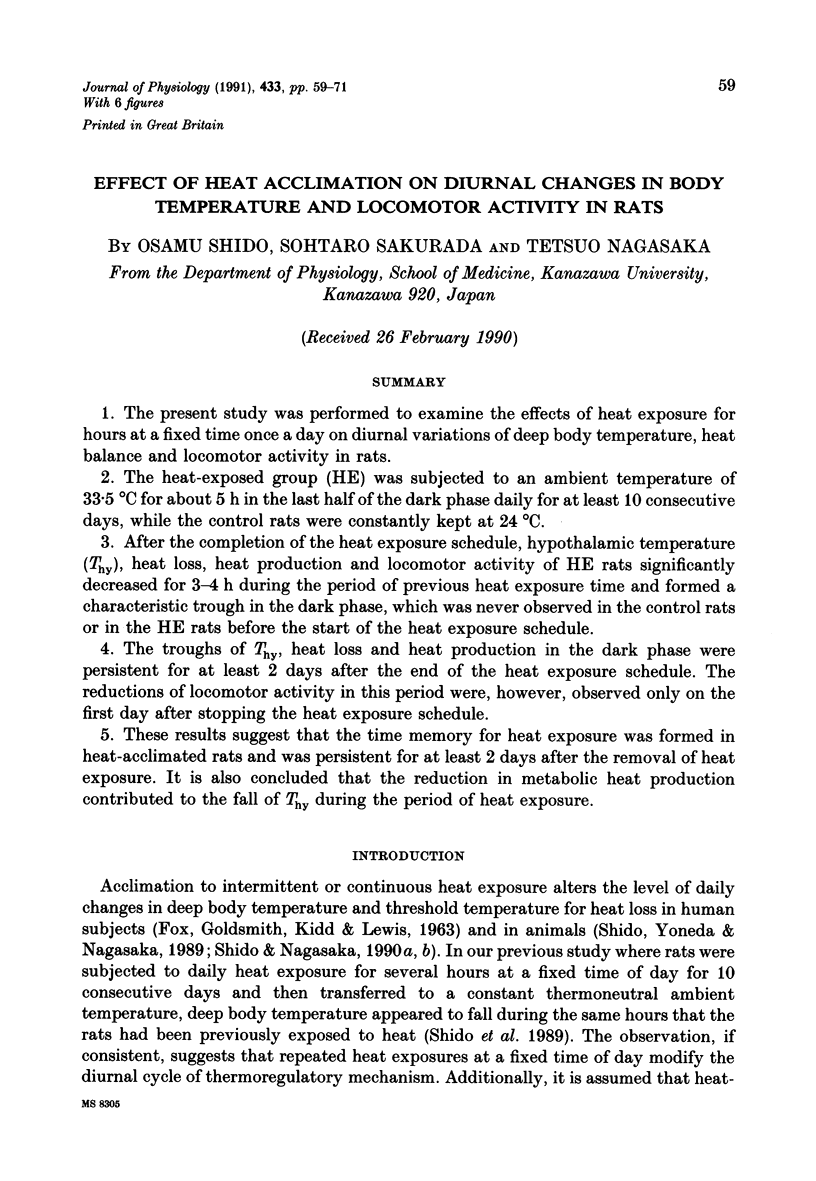
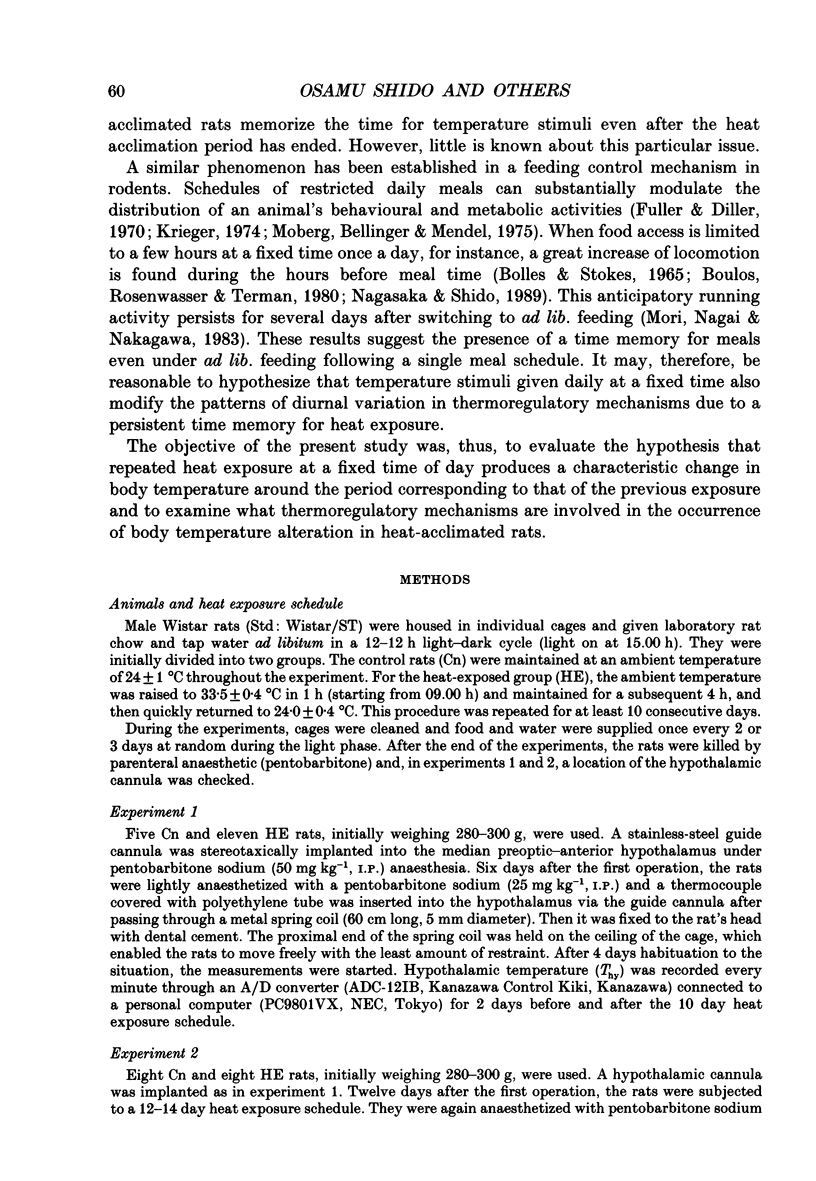
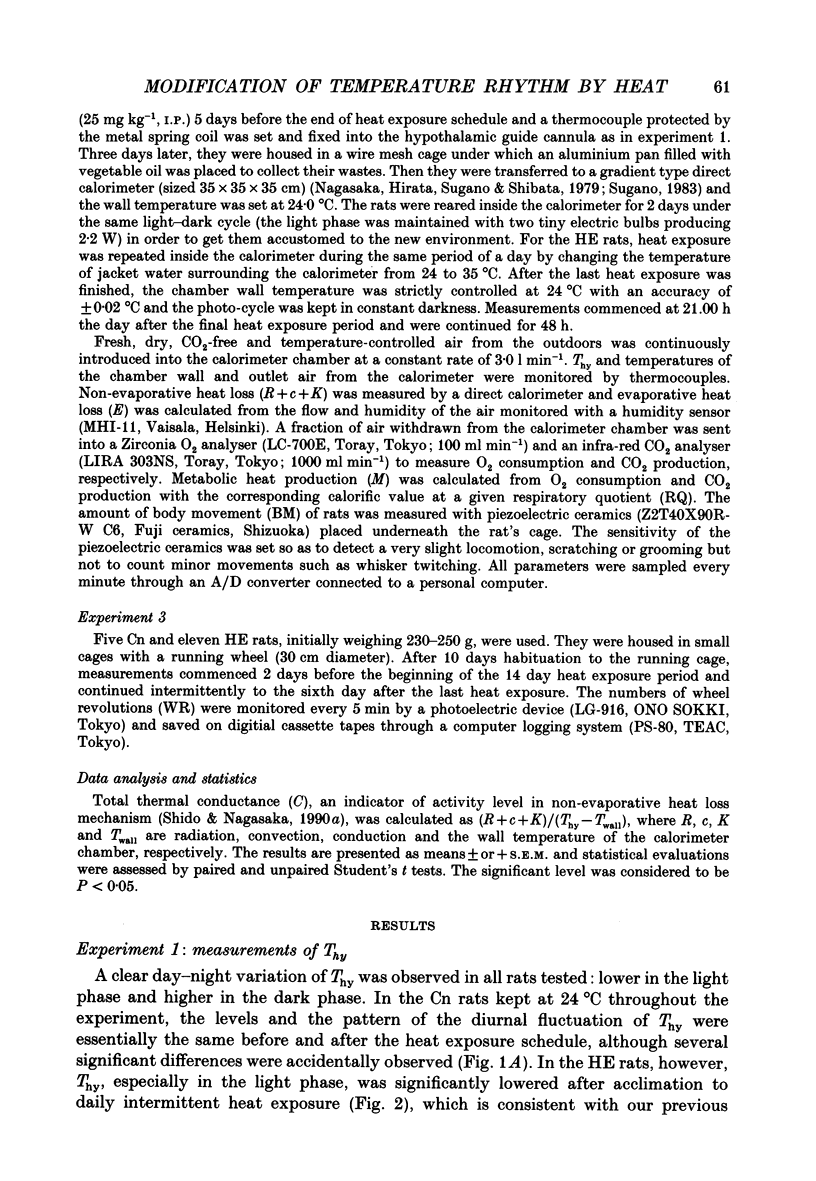
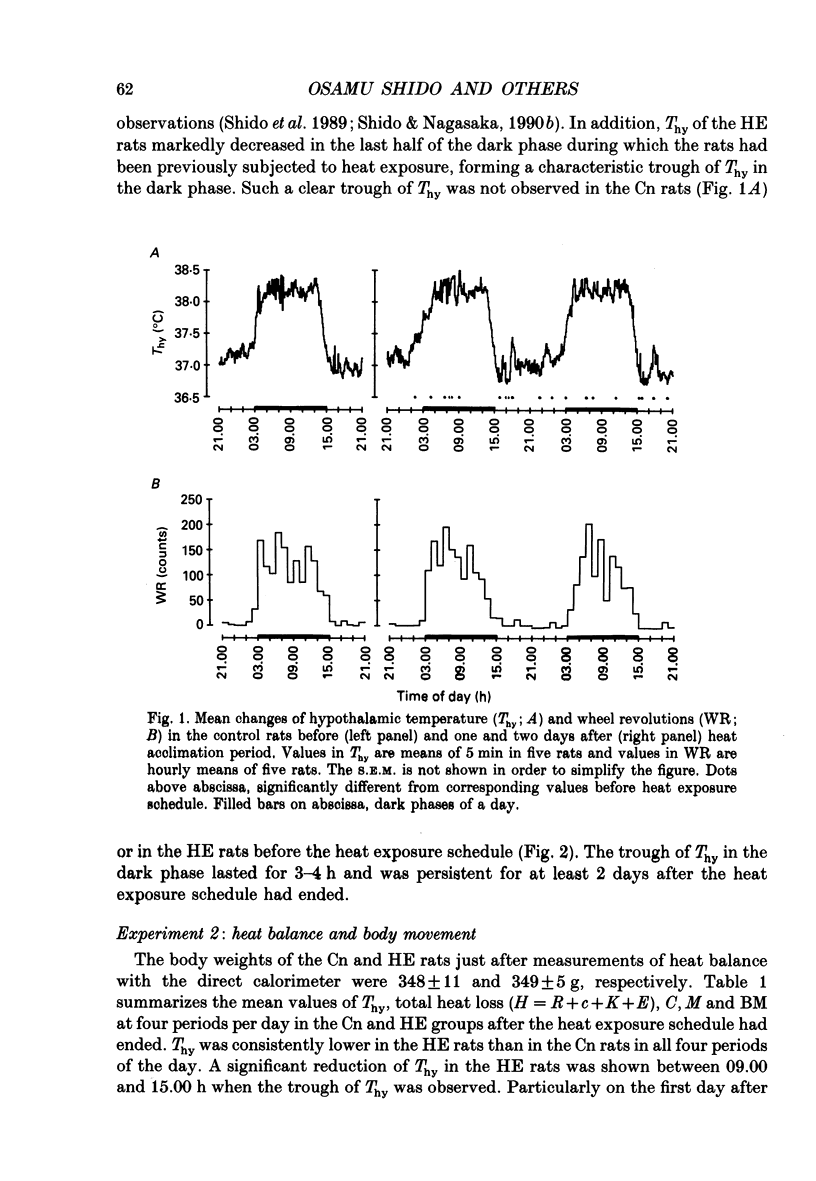
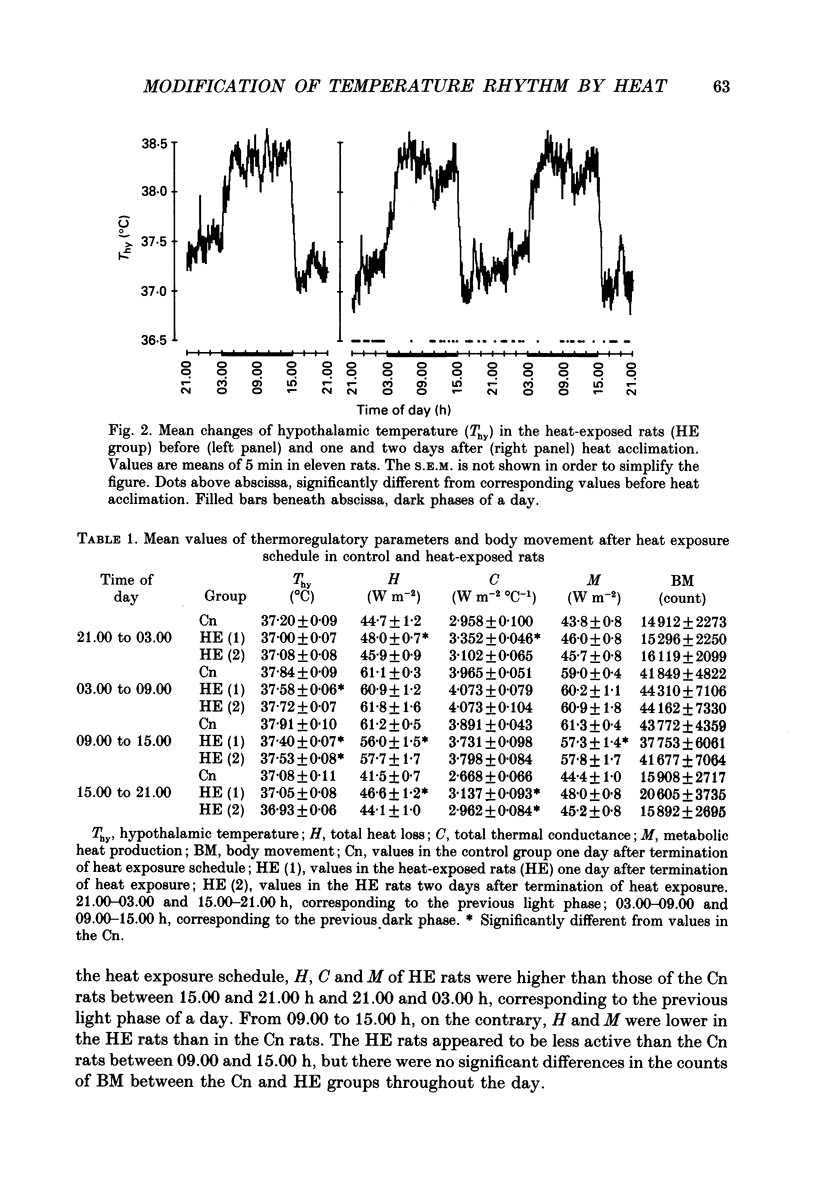
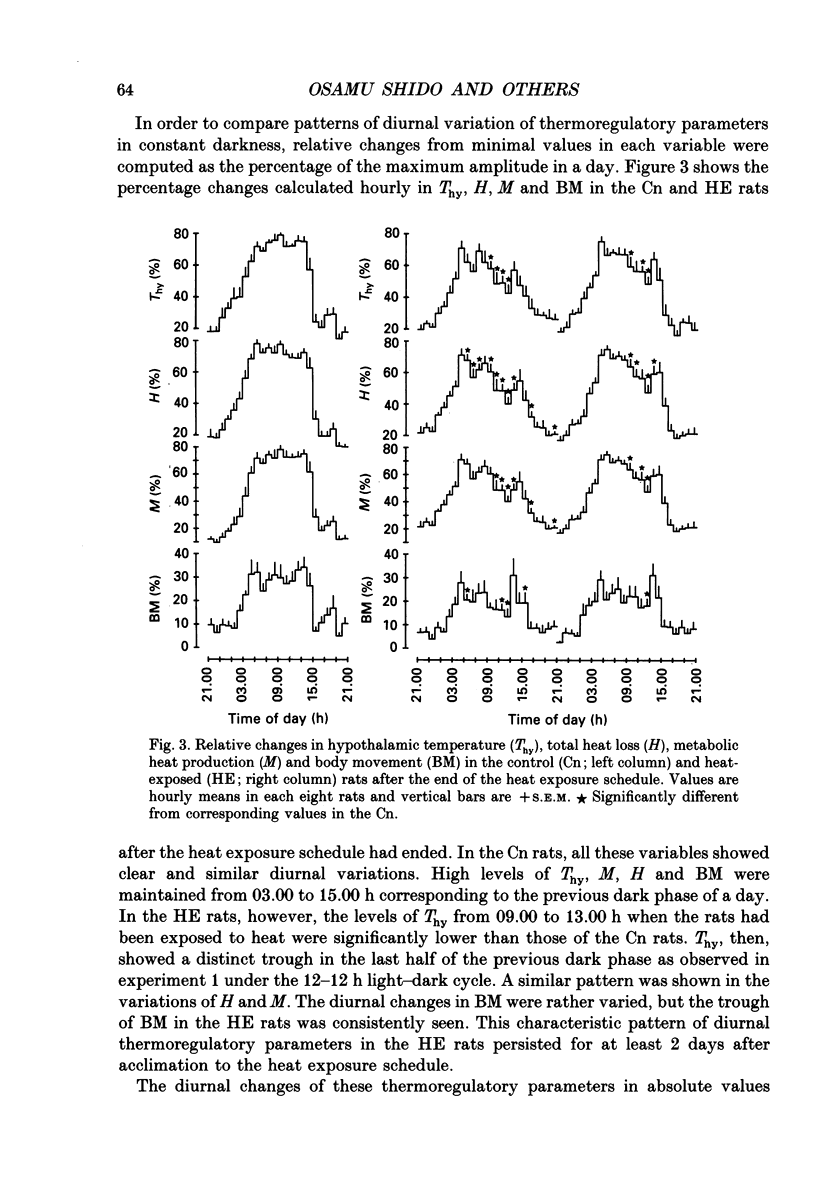
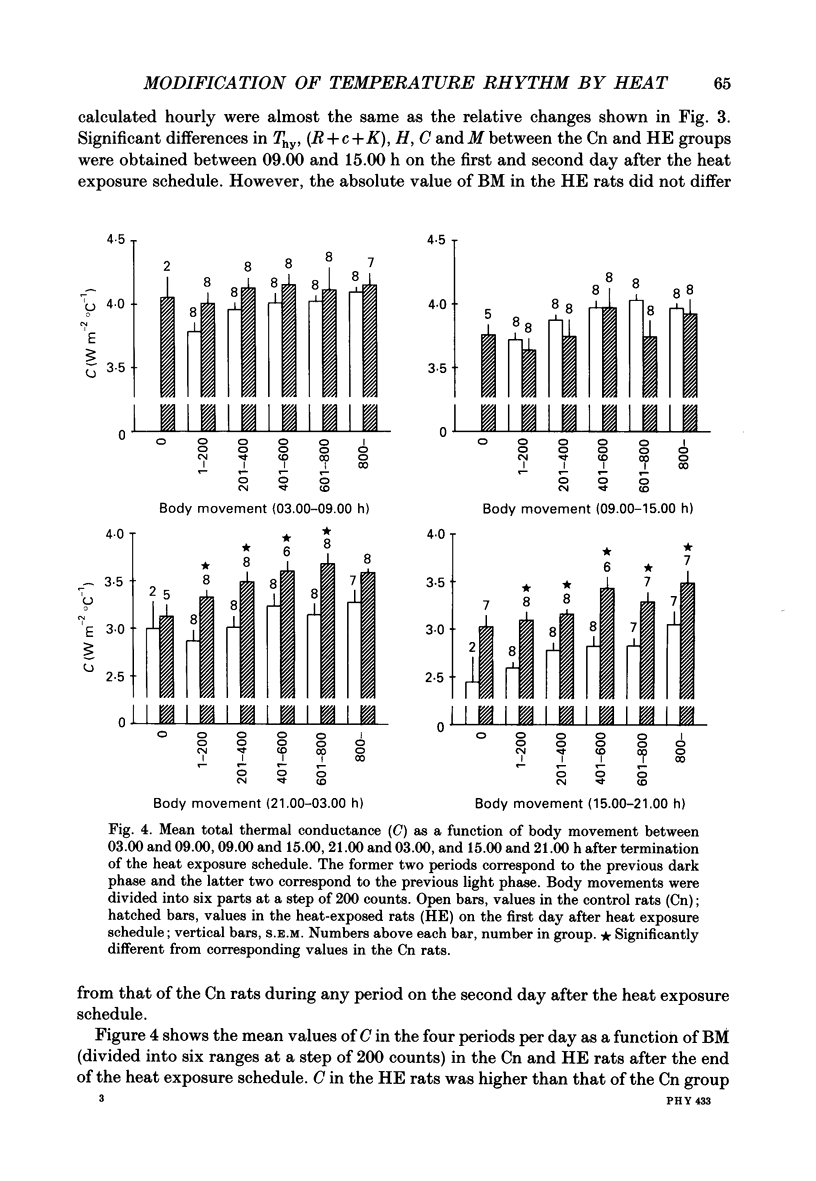
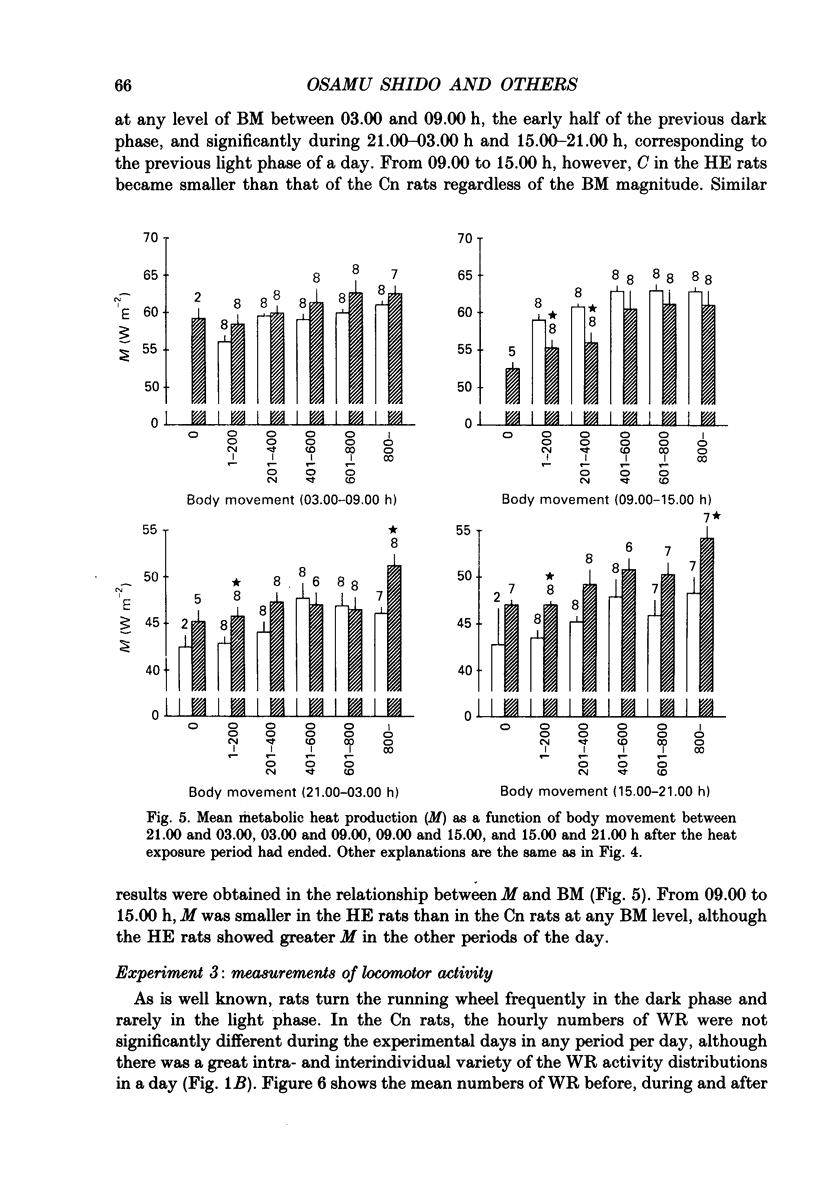
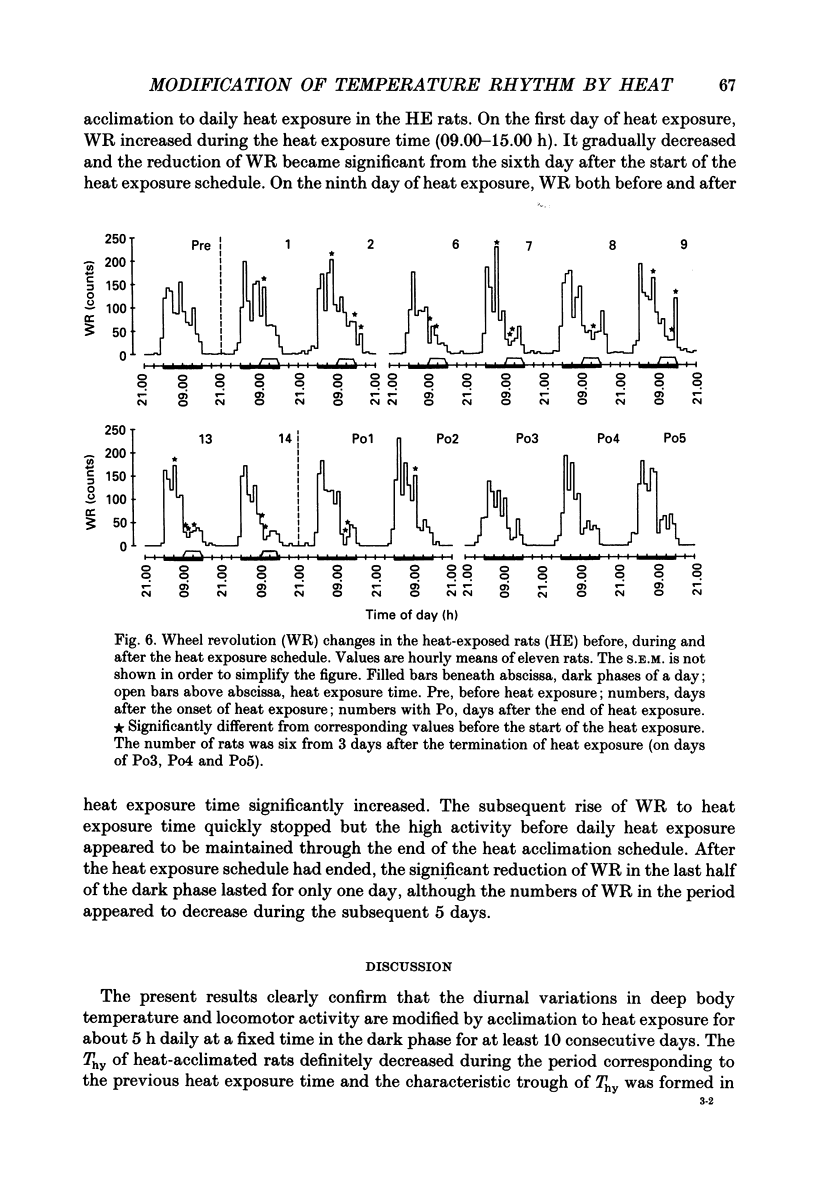
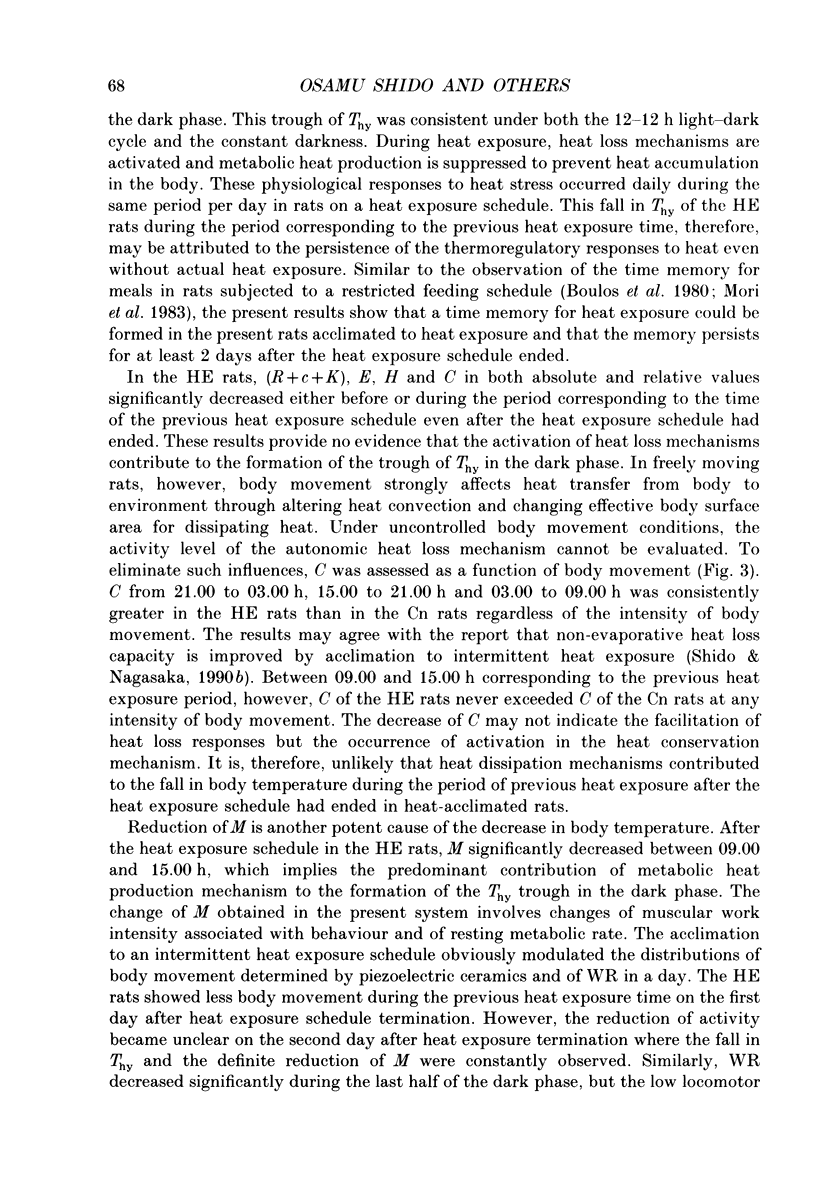
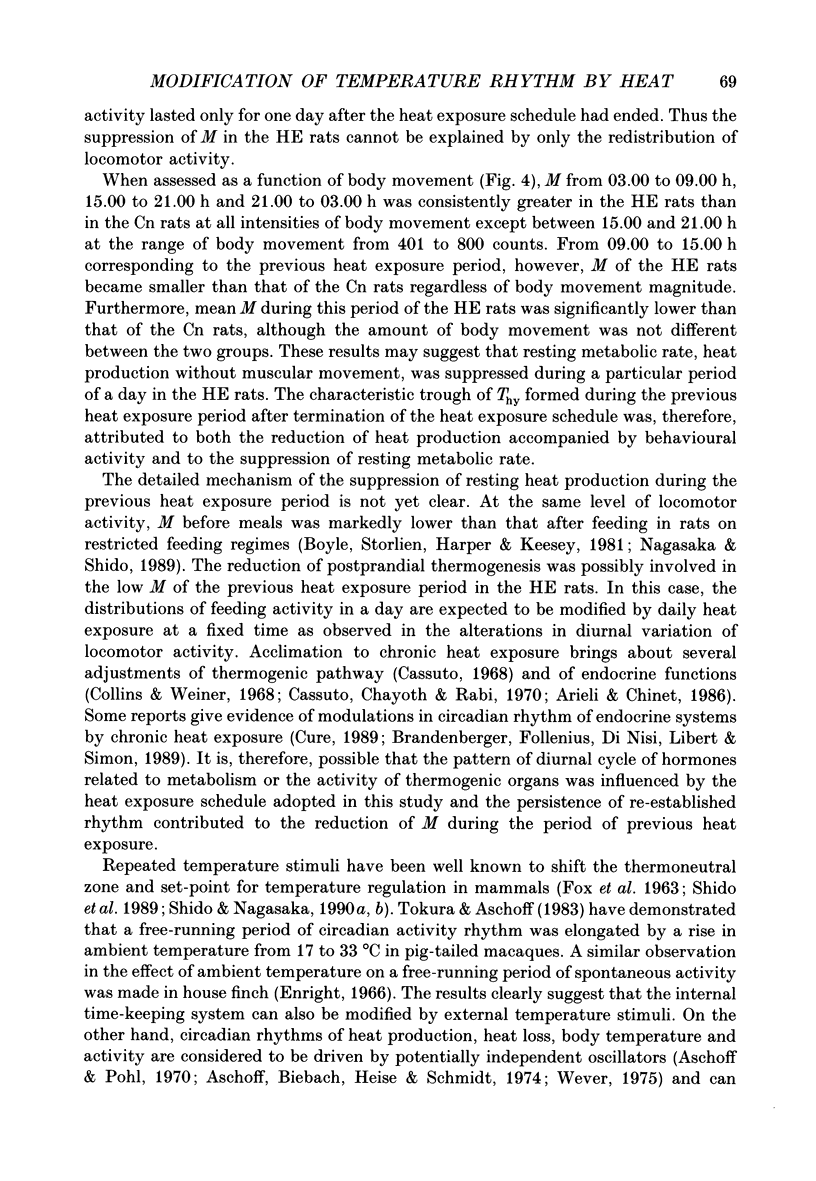
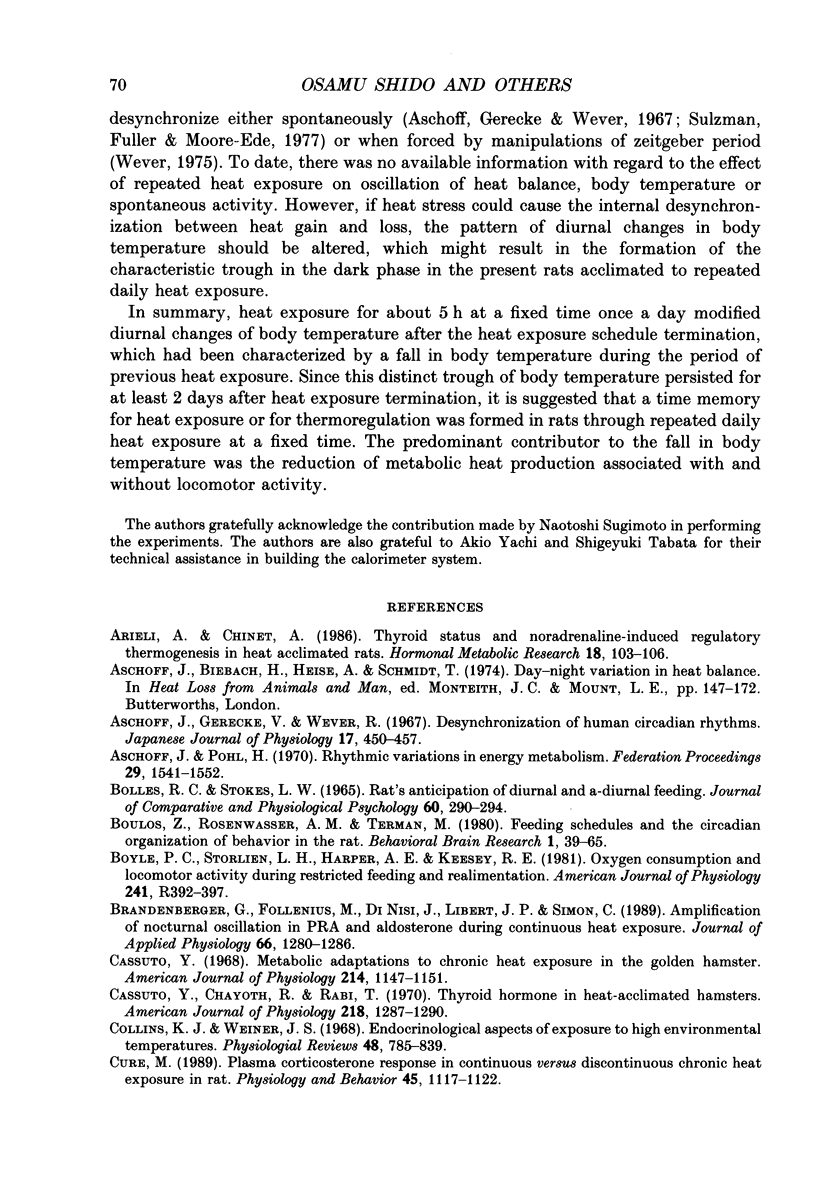
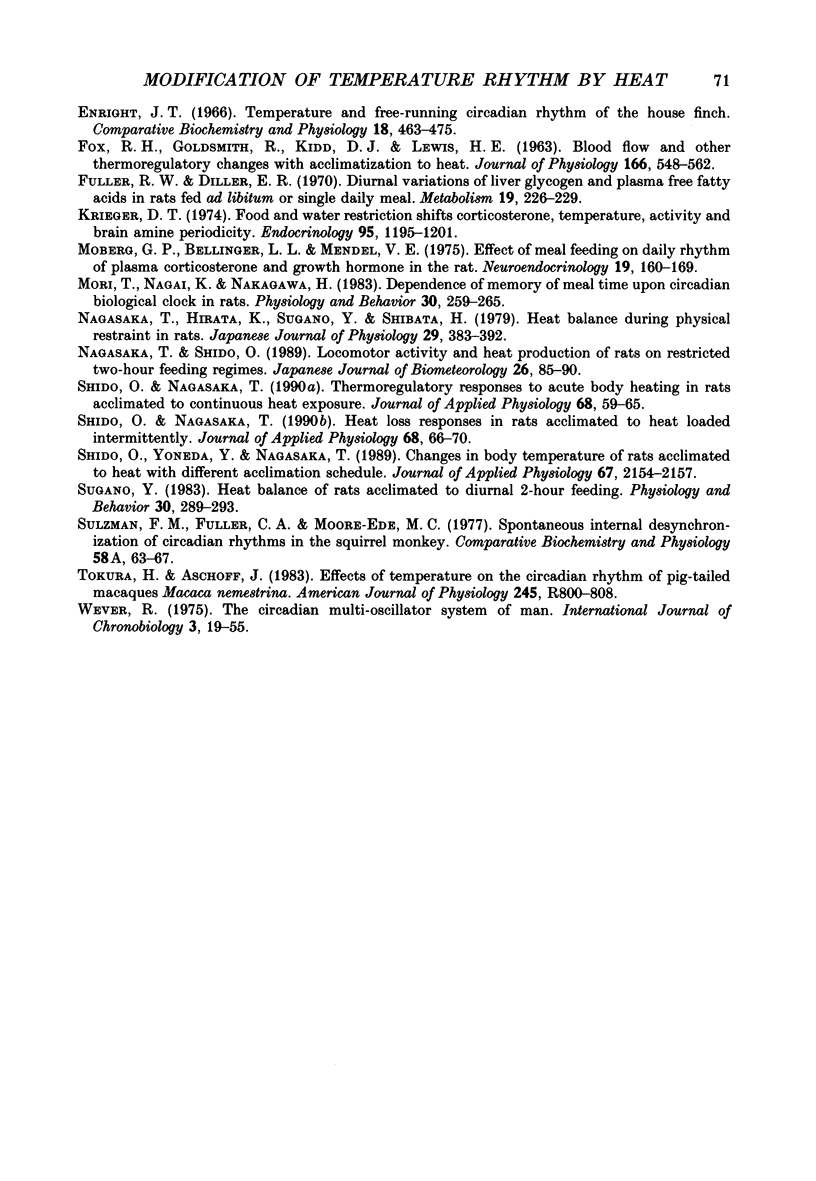
Selected References
These references are in PubMed. This may not be the complete list of references from this article.
- Arieli A., Chinet A. Thyroid status and noradrenaline-induced regulatory thermogenesis in heat acclimated rats. Horm Metab Res. 1986 Feb;18(2):103–106. doi: 10.1055/s-2007-1012242. [DOI] [PubMed] [Google Scholar]
- Aschoff J., Gerecke U., Wever R. Desynchronization of human circadian rhythms. Jpn J Physiol. 1967 Aug 15;17(4):450–457. doi: 10.2170/jjphysiol.17.450. [DOI] [PubMed] [Google Scholar]
- Aschoff J., Pohl H. Rhythmic variations in energy metabolism. Fed Proc. 1970 Jul-Aug;29(4):1541–1552. [PubMed] [Google Scholar]
- Bolles R. C., Stokes L. W. Rat's anticipation of diurnal and a-diurnal feeding. J Comp Physiol Psychol. 1965 Oct;60(2):290–294. doi: 10.1037/h0022308. [DOI] [PubMed] [Google Scholar]
- Boulos Z., Rosenwasser A. M., Terman M. Feeding schedules and the circadian organization of behavior in the rat. Behav Brain Res. 1980 Feb;1(1):39–65. doi: 10.1016/0166-4328(80)90045-5. [DOI] [PubMed] [Google Scholar]
- Boyle P. C., Storlien L. H., Harper A. E., Keesey R. E. Oxygen consumption and locomotor activity during restricted feeding and realimentation. Am J Physiol. 1981 Nov;241(5):R392–R397. doi: 10.1152/ajpregu.1981.241.5.R392. [DOI] [PubMed] [Google Scholar]
- Brandenberger G., Follenius M., Di Nisi J., Libert J. P., Simon C. Amplification of nocturnal oscillations in PRA and aldosterone during continuous heat exposure. J Appl Physiol (1985) 1989 Mar;66(3):1280–1286. doi: 10.1152/jappl.1989.66.3.1280. [DOI] [PubMed] [Google Scholar]
- Cassuto Y., Chayoth R., Rabi T. Thyroid hormone in heat-acclimated hamsters. Am J Physiol. 1970 May;218(5):1287–1290. doi: 10.1152/ajplegacy.1970.218.5.1287. [DOI] [PubMed] [Google Scholar]
- Cassuto Y. Metabolic adaptations to chronic heat exposure in the golden hamster. Am J Physiol. 1968 May;214(5):1147–1151. doi: 10.1152/ajplegacy.1968.214.5.1147. [DOI] [PubMed] [Google Scholar]
- Collins K. J., Weiner J. S. Endocrinological aspects of exposure to high environmental temperatures. Physiol Rev. 1968 Oct;48(4):785–839. doi: 10.1152/physrev.1968.48.4.785. [DOI] [PubMed] [Google Scholar]
- Cure M. Plasma corticosterone response in continuous versus discontinuous chronic heat exposure in rat. Physiol Behav. 1989 Jun;45(6):1117–1122. doi: 10.1016/0031-9384(89)90097-8. [DOI] [PubMed] [Google Scholar]
- Enright J. T. Temperature and the free-running circadian rhythm of the house finch. Comp Biochem Physiol. 1966 Jun;18(2):463–475. doi: 10.1016/0010-406x(66)90201-5. [DOI] [PubMed] [Google Scholar]
- FOX R. H., GOLDSMITH R., KIDD D. J., LEWIS H. E. Blood flow and other thermoregulatory changes with acclimatization to heat. J Physiol. 1963 May;166:548–562. doi: 10.1113/jphysiol.1963.sp007122. [DOI] [PMC free article] [PubMed] [Google Scholar]
- Fuller R. W., Diller E. R. Diurnal variation of liver glycogen and plasma free fatty acids in rats fed ad libitum or single daily meal. Metabolism. 1970 Mar;19(3):226–229. doi: 10.1016/0026-0495(70)90056-9. [DOI] [PubMed] [Google Scholar]
- Krieger D. T. Food and water restriction shifts corticosterone, temperature, activity and brain amine periodicity. Endocrinology. 1974 Nov;95(5):1195–1201. doi: 10.1210/endo-95-5-1195. [DOI] [PubMed] [Google Scholar]
- Moberg G. P., Bellinger L. L., Mendel V. E. Effect of meal feeding on daily rhythms of plasma corticosterone and growth hormone in the rat. Neuroendocrinology. 1975;19(2):160–169. doi: 10.1159/000122436. [DOI] [PubMed] [Google Scholar]
- Mori T., Nagai K., Nakagawa H. Dependence of memory of meal time upon circadian biological clock in rats. Physiol Behav. 1983 Feb;30(2):259–265. doi: 10.1016/0031-9384(83)90016-1. [DOI] [PubMed] [Google Scholar]
- Nagasaka T., Hirata K., Sugano Y., Shibata H. Heat balance during physical restraint in rats. Jpn J Physiol. 1979;29(4):383–392. doi: 10.2170/jjphysiol.29.383. [DOI] [PubMed] [Google Scholar]
- Shido O., Nagasaka T. Heat loss responses in rats acclimated to heat loaded intermittently. J Appl Physiol (1985) 1990 Jan;68(1):66–70. doi: 10.1152/jappl.1990.68.1.66. [DOI] [PubMed] [Google Scholar]
- Shido O., Nagasaka T. Thermoregulatory responses to acute body heating in rats acclimated to continuous heat exposure. J Appl Physiol (1985) 1990 Jan;68(1):59–65. doi: 10.1152/jappl.1990.68.1.59. [DOI] [PubMed] [Google Scholar]
- Shido O., Yoneda Y., Nagasaka T. Changes in body temperature of rats acclimated to heat with different acclimation schedules. J Appl Physiol (1985) 1989 Nov;67(5):2154–2157. doi: 10.1152/jappl.1989.67.5.2154. [DOI] [PubMed] [Google Scholar]
- Sugano Y. Heat balance of rats acclimated to diurnal 2-hour feeding. Physiol Behav. 1983 Feb;30(2):289–293. doi: 10.1016/0031-9384(83)90021-5. [DOI] [PubMed] [Google Scholar]
- Tokura H., Aschoff J. Effects of temperature on the circadian rhythm of pig-tailed macaques Macaca nemestrina. Am J Physiol. 1983 Dec;245(6):R800–R804. doi: 10.1152/ajpregu.1983.245.6.R800. [DOI] [PubMed] [Google Scholar]
- Wever R. The circadian multi-oscillatory system of man. Int J Chronobiol. 1975;3(1):19–55. [PubMed] [Google Scholar]


